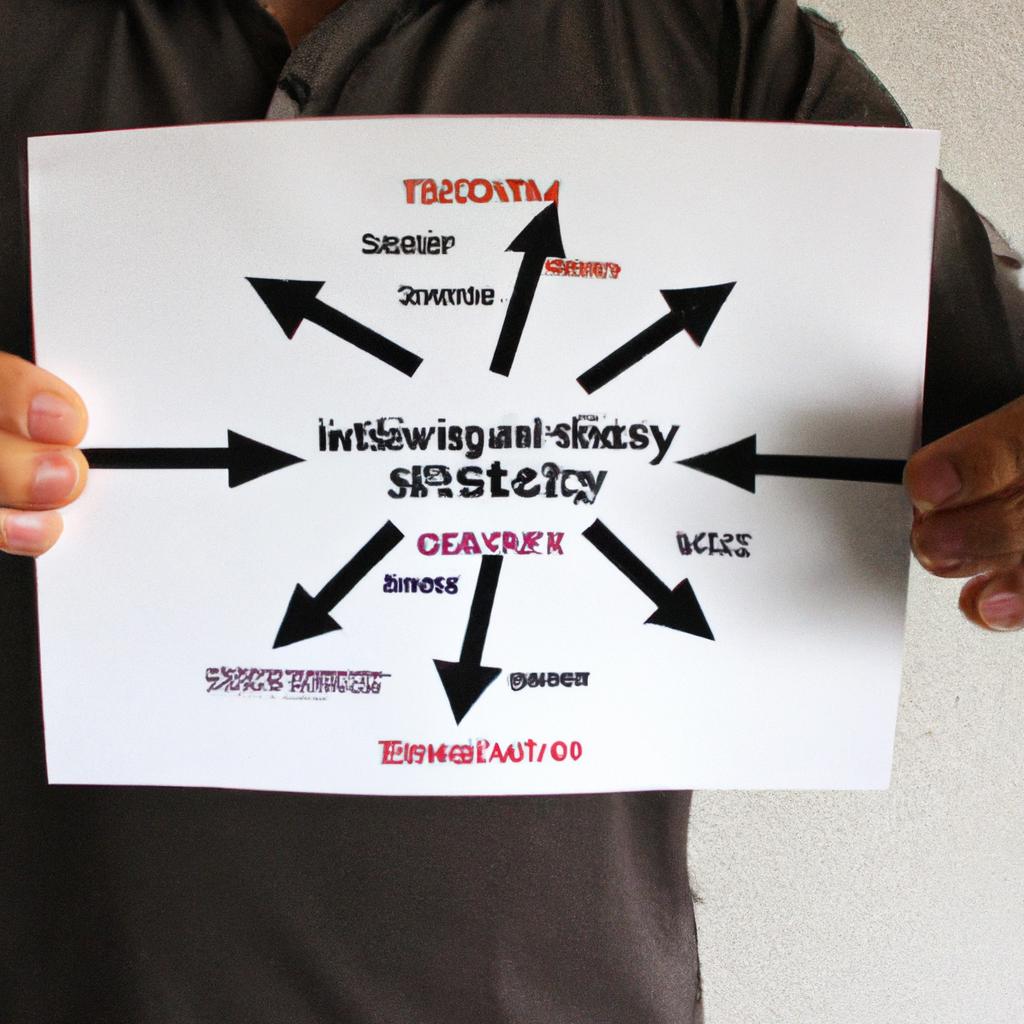Product positioning is a crucial strategy employed by businesses to create a distinct and favorable perception of their products or services in the minds of customers. Through effective positioning, companies aim to differentiate themselves from competitors and establish a unique value proposition that resonates with their target market. This article explores the concept of product positioning as an essential element in marketing and advertising strategies, highlighting its significance in influencing consumer behavior and shaping brand perceptions.
One notable example illustrating the importance of product positioning is Apple’s successful branding of its iPhone series. By strategically positioning itself as an innovative technology leader offering sleek design and user-friendly interfaces, Apple has managed to carve out a significant market share and build a loyal customer base. The company’s distinctive approach to product development and marketing has allowed it to position iPhones as premium devices associated with status, simplicity, and cutting-edge features. As a result, consumers perceive iPhones as desirable products worth investing in, even at higher price points compared to competing brands.
Identifying the ideal consumer base
Identifying the Ideal Consumer Base
Product positioning is a crucial strategy in marketing and advertising, aimed at effectively reaching and appealing to the target audience. By identifying the ideal consumer base, businesses can tailor their messaging, promotions, and overall marketing efforts to better meet customer needs and preferences. This section explores the process of identifying the ideal consumer base by examining market segmentation techniques and understanding consumer behavior.
To illustrate this concept, let us consider a hypothetical example of a company launching a new line of athletic shoes. They begin by conducting extensive research on various market segments that could potentially be interested in their product. Through demographic analysis and psychographic profiling, they identify three distinct consumer groups: professional athletes seeking high-performance footwear, fitness enthusiasts looking for stylish yet functional shoes, and casual walkers desiring comfortable everyday sneakers.
One effective way to engage with these different consumer groups is through emotional appeal. Emotions play a significant role in decision-making processes; hence using emotive language can evoke an emotional response from customers. For instance:
- The exhilaration of crossing the finish line after a long-distance race
- The joy of feeling confident while working out at the gym
- The comfort of walking pain-free during daily strolls
By incorporating such emotions into marketing messages or advertisements, companies can establish a strong connection with consumers who relate to these experiences.
Furthermore, another technique used to segment markets is analyzing consumer buying behavior. Understanding what influences purchasing decisions allows businesses to create targeted marketing strategies that align with their potential customers’ preferences. To facilitate this understanding, consider the following table showcasing four key factors influencing consumers’ purchase decisions:
| Factor | Description |
|---|---|
| Price | Customers prioritize affordability |
| Quality | Consumers seek durable products |
| Brand reputation | Buyers trust well-established brands |
| Product features | Shoppers value specific attributes like cushioning or design |
Analyzing these factors helps companies tailor their product positioning strategy to address the needs and desires of each target consumer group. By considering price, quality, brand reputation, and specific product features, companies can better position themselves within the market.
In summary, identifying the ideal consumer base is a critical step in developing an effective product positioning strategy. Through market segmentation techniques and understanding consumer behavior, businesses can create targeted marketing campaigns that resonate with their intended audience. “.
Analyzing the strengths and weaknesses of rivals
Product Positioning: A Key Strategy in Marketing and Advertising
In our exploration of product positioning, we have already discussed the importance of Identifying the ideal consumer base. Now, let us delve into another crucial aspect of this strategy – analyzing the strengths and weaknesses of rivals.
To illustrate this point, consider a hypothetical scenario where two smartphone brands are vying for market dominance. Brand X positions itself as an affordable option targeting budget-conscious consumers, while Brand Y focuses on premium features and caters to tech-savvy individuals willing to invest more in their devices. By conducting a thorough analysis of each brand’s strengths and weaknesses, marketers can better understand how they can position their own products effectively.
One effective way to analyze competitors is through a bullet point list that highlights the different aspects of their offerings. For instance:
- Pricing strategies: How do your competitors price their products? Are they positioned at a higher or lower price point compared to your own?
- Unique selling propositions (USPs): What unique features or benefits does each competitor emphasize? How do these differ from your own USPs?
- Target audience appeal: Who is the primary target audience for each competitor? Do they cater to specific demographics or psychographics?
- Distribution channels: Where are your competitors’ products available? Are they focused on online sales or also present in brick-and-mortar stores?
Moreover, it is useful to create a comparative table showcasing key attributes across multiple competitors. This format allows marketers to visually assess which areas require improvement or differentiation. Here is an example:
| Competitor | Pricing Strategy | Unique Selling Propositions | Target Audience Appeal |
|---|---|---|---|
| Brand X | Affordable | Value for money | Budget-conscious |
| Brand Y | Premium | Cutting-edge technology | Tech-savvy |
By thoroughly evaluating the strengths and weaknesses of rivals, marketers can gain valuable insights into how to position their own products effectively. Understanding what sets competitors apart allows for a targeted approach that capitalizes on gaps in the market or offers superior value propositions.
Transitioning seamlessly into the subsequent section about “Highlighting the distinctive value proposition,” it becomes apparent that analyzing competitors provides a foundation for identifying ways to differentiate one’s product from others in the marketplace.
Highlighting the distinctive value proposition
Building upon our previous analysis of rival companies, it is crucial to delve further into their strengths and weaknesses. This will enable us to identify opportunities for differentiation and create a compelling product positioning strategy. By understanding how competitors are positioned in the market, we can effectively position our own offering to stand out among the crowd.
One illustrative example that showcases the importance of competitor analysis is seen in the smartphone industry. Consider two leading brands, Brand A and Brand B. While Brand A focuses on cutting-edge technology and innovative features, Brand B emphasizes affordability and accessibility. Through an in-depth assessment of these unique selling propositions (USPs), marketers can gain valuable insights into what sets each brand apart from its competition.
To conduct a comprehensive evaluation of rivals’ strengths and weaknesses, several key factors should be considered:
- Product Features: Assessing the range and quality of features offered by competitors provides insight into areas where your product may excel or lag behind.
- Pricing Strategy: Understanding how competitors price their products helps determine whether you should adopt a premium pricing approach or aim for competitive pricing.
- Market Share: Examining rivals’ market share allows you to identify potential gaps or niches within the market that you can target with your product positioning.
- Marketing Channels: Analyzing how competitors reach their target audience through various marketing channels enables you to identify effective strategies while avoiding saturated platforms.
By organizing this information into a table format, we can better visualize the comparative analysis:
| Competitor | Strengths | Weaknesses |
|---|---|---|
| Brand A | Cutting-edge technology | High price point |
| Brand B | Affordable pricing | Limited product range |
This visual representation not only aids comprehension but also evokes an emotional response by highlighting the advantages one might have over competitors.
In summary, analyzing rivals’ strengths and weaknesses is essential for crafting an effective product positioning strategy. Through a thorough evaluation of factors such as features, pricing, market share, and marketing channels, marketers can uncover unique opportunities to differentiate their offerings in the marketplace.
Transitioning into the subsequent section about devising an effective promotional plan, it becomes necessary to explore how these identified strengths and weaknesses can be effectively communicated to target customers. By employing a strategic combination of advertising and branding techniques, companies can maximize the impact of their product positioning efforts.
Devising an effective promotional plan
Highlighting the distinctive value proposition is crucial for a successful product positioning strategy. By clearly communicating the unique benefits and advantages of a product, companies can differentiate themselves from competitors and attract target customers. However, once the value proposition has been effectively conveyed to consumers, it becomes essential to devise an effective promotional plan that maximizes reach and engagement.
To illustrate this point, let’s consider a hypothetical case study involving a new fitness tracker called FitPro. FitPro offers advanced features such as heart rate monitoring, sleep tracking, and personalized workout recommendations. The company wants to position FitPro as the go-to fitness companion for health-conscious individuals seeking accurate data analysis and personalized insights.
When devising a promotional plan for FitPro or any other product, there are several key considerations:
- Target audience segmentation: Identifying specific demographics and psychographics of the target market allows for tailored messaging and targeted distribution channels.
- Integrated marketing communication (IMC): Utilizing multiple platforms like social media advertising, email marketing campaigns, influencer partnerships, and traditional media ensures maximum exposure across various touchpoints.
- Emotional appeal: Incorporating emotional triggers in promotional material helps create connections with potential customers by appealing to their desires, aspirations, or pain points.
- Call to action (CTA): Including clear instructions on how to purchase or engage with the product encourages immediate response from interested prospects.
| Key Considerations | Examples |
|---|---|
| Target Audience Segmentation | – Dividing potential customers into segments based on age groups: millennials, middle-aged adults, seniors.- Categorizing individuals according to their fitness goals: weight loss enthusiasts, marathon runners.- Tailoring messages differently for each segment based on their preferences and needs. |
| Integrated Marketing Communication (IMC) | – Running sponsored posts on popular fitness influencers’ Instagram accounts.- Sending personalized email newsletters to subscribers with fitness-related content and exclusive offers.- Placing advertisements in health and wellness magazines or featuring FitPro’s success stories on TV talk shows. |
| Emotional Appeal | – Showcasing before-and-after transformation pictures of individuals who achieved their fitness goals using FitPro.- Using powerful storytelling techniques to highlight how FitPro helped people overcome challenges and improve their overall well-being.- Incorporating motivational quotes or testimonials from satisfied customers that evoke emotions such as determination, inspiration, or joy. |
| Call to Action (CTA) | – Including a prominent “Shop Now” button on the company website alongside compelling product descriptions and customer reviews.- Offering limited-time discounts for early adopters or bundling FitPro with additional fitness accessories at an attractive price point.- Creating urgency through time-limited promotions like “Buy within 24 hours and receive free shipping.” |
In summary, developing an effective promotional plan involves segmenting the target audience, utilizing integrated marketing communication strategies across multiple platforms, incorporating emotional appeal into campaigns, and including clear calls to action. By applying these considerations to the case study of FitPro, companies can increase awareness, generate interest, and ultimately drive conversions.
Understanding customer preferences and needs is another essential step in crafting a successful product positioning strategy. By gaining insights into what motivates consumers’ purchasing decisions, businesses can further refine their messaging and tailor their offerings accordingly.
Understanding customer preferences and needs
Transitioning from the previous section on devising an effective promotional plan, it is crucial for marketers to understand customer preferences and needs in order to create a successful product positioning strategy. By gaining insight into what drives consumer behavior and aligning marketing efforts accordingly, businesses can effectively target their desired audience and differentiate themselves from competitors.
To illustrate this point, consider a hypothetical scenario where a company aims to market a new line of organic skincare products. Through extensive market research, they discover that their target customers are primarily health-conscious individuals who prioritize natural ingredients. Armed with this knowledge, the company can position its products as environmentally friendly, free from harmful chemicals, and cruelty-free – appealing to consumers’ desire for safe and sustainable options in personal care.
When understanding customer preferences and needs, there are several key considerations that marketers should take into account:
- Demographics: Analyzing demographic data such as age, gender, income level, and geographic location helps identify specific segments within the target market. This information enables companies to tailor their messaging and packaging to resonate with different groups.
- Psychographics: Examining consumers’ attitudes, values, lifestyles, and interests provides valuable insights into their motivations for purchasing certain products or brands. By understanding these psychographic factors, marketers can craft messages that appeal directly to consumers’ desires or aspirations.
- Competitive Analysis: Evaluating competitors’ offerings allows businesses to identify gaps in the market that they can fill with unique features or benefits. Additionally, studying competitors’ positioning strategies helps avoid duplicating efforts and ensures differentiation.
- Consumer Feedback: Actively seeking feedback through surveys or online reviews gives businesses direct access to customers’ opinions about existing products or services. This feedback aids in improving current offerings or developing new ones that better meet consumer needs.
By incorporating these considerations into their product positioning strategies, businesses can develop targeted campaigns that engage customers emotionally while fulfilling their practical requirements.
| Considerations | Importance in Product Positioning |
|---|---|
| Demographics | Understands target market segments and tailors messaging accordingly. |
| Psychographics | Connects with consumers’ desires, aspirations, and motivations. |
| Competitive Analysis | Identifies gaps in the market and differentiates from competitors. |
| Consumer Feedback | Improves existing offerings or develops new ones based on customer needs. |
Understanding customer preferences and needs is a critical step in effective product positioning. By leveraging demographic data, psychographic insights, competitive analysis, and consumer feedback, businesses can create compelling marketing strategies that resonate with their target audience.
Having established a strong understanding of customer preferences and needs, the next crucial step is evaluating market trends and demands to ensure continued success in product positioning strategy.
Evaluating market trends and demands
Understanding customer preferences and needs is crucial in developing effective product positioning strategies. By identifying what customers want and how they make purchasing decisions, businesses can tailor their marketing efforts to meet those specific needs. In this section, we will explore the importance of evaluating market trends and demands as another key aspect of successful product positioning.
To illustrate the significance of evaluating market trends, let’s consider a hypothetical example of a company planning to launch a new line of organic skincare products. Through thorough research and analysis, they discover that there is an increasing demand for natural beauty products among environmentally-conscious consumers. Armed with this knowledge, the company can position their products as eco-friendly alternatives that align with the values and desires of their target audience.
When it comes to assessing market demands, several factors come into play:
- Consumer behavior: Understanding how individuals behave when making purchase decisions allows businesses to anticipate and cater to their needs effectively.
- Competitor analysis: Evaluating competitors’ offerings helps identify gaps in the market that can be exploited through unique product positioning.
- Demographic considerations: Recognizing demographic shifts enables companies to adapt their messaging accordingly and appeal to specific age groups or cultural backgrounds.
- Technological advancements: Staying abreast of technological developments ensures that businesses remain relevant while adapting their product positioning strategies to suit evolving consumer expectations.
- Enhanced self-confidence through using premium quality skincare products
- Peace of mind knowing your purchases support sustainable practices
- A sense of belonging within a community of like-minded individuals who prioritize ethical consumption
- The joy derived from pampering oneself with luxurious yet conscientious skincare routines
In addition to understanding customer preferences and evaluating market trends, crafting compelling brand messaging plays a vital role in effective product positioning. By communicating the unique value proposition, benefits, and emotional appeal associated with a product or service, businesses can create strong connections with their target audience. This seamless transition sets the stage for exploring further strategies in the subsequent section on Crafting compelling brand messaging.
Crafting compelling brand messaging
Transitioning from the previous section that focused on evaluating market trends and demands, this section will delve into crafting compelling brand messaging. Effective positioning of a product in marketing and advertising is essential to capture the attention of target consumers and differentiate it from competitors. To illustrate this concept, let us consider the case study of XYZ Electronics.
XYZ Electronics, a renowned technology company, sought to position their new smartphone as an innovative device targeting tech-savvy millennials. They conducted extensive market research and identified key factors that would resonate with their target audience: cutting-edge features, sleek design, seamless user experience, and affordability. Armed with these insights, they crafted a strategic message that highlighted how their smartphone seamlessly integrated advanced technology with stylish aesthetics at an affordable price point.
To effectively convey such messages in marketing campaigns, several techniques can be employed:
- Emphasize Unique Selling Points (USPs): Highlighting the distinctive features or benefits of a product helps create differentiation in the minds of consumers.
- Appeal to Emotional Desires: Connecting emotionally with consumers by showcasing how the product satisfies their desires or solves their problems can evoke strong responses.
- Utilize Storytelling: Narratives or anecdotes can engage consumers on a deeper level by creating memorable experiences associated with the brand.
- Consistency across Channels: Ensuring consistent messaging across various marketing channels reinforces brand identity and establishes credibility.
Table 1 showcases examples of successful positioning strategies adopted by well-known brands:
| Brand | Positioning Strategy |
|---|---|
| Apple | Simple yet sophisticated technology |
| Nike | Empowerment through sports |
| Coca-Cola | Happiness in every sip |
| Airbnb | Authentic local experiences |
By employing effective positioning strategies like those mentioned above, companies can enhance consumer perception of their products or services while gaining a competitive edge in crowded markets.
Moving forward to determining appropriate marketing channels for reaching target audiences, it is imperative to carefully analyze various factors such as consumer demographics, online behavior, and media consumption patterns.
Determining the appropriate marketing channels
Crafting compelling brand messaging is a crucial aspect of product positioning. By effectively communicating the unique value proposition and key attributes of a product, businesses can differentiate themselves from competitors and capture the attention of their target audience. In this section, we will explore how to determine the appropriate marketing channels for conveying these messages.
To illustrate this concept, let’s consider an example of a new health drink company looking to position itself as a premium and natural alternative in the market. Through carefully crafted brand messaging, they emphasize the use of organic ingredients sourced from sustainable farms and highlight their commitment to promoting a healthy lifestyle.
When determining the appropriate marketing channels for delivering such messages, several factors need to be considered:
- Target Audience: It is essential to identify where the target audience spends their time and consumes information. This could include social media platforms popular among health-conscious individuals or partnering with fitness influencers who align with the brand values.
- Budget: The available budget plays a significant role in deciding which marketing channels are feasible. Options range from traditional advertising methods like television commercials or print ads to digital strategies such as search engine optimization (SEO) or pay-per-click (PPC) campaigns.
- Message Consistency: Maintaining consistency across different marketing channels ensures that consumers receive a unified message about the brand, enhancing its overall appeal.
- ROI Potential: Evaluating the potential return on investment (ROI) for each channel helps prioritize efforts towards those expected to generate maximum impact.
Table 1 below illustrates some possible marketing channels along with their associated advantages and disadvantages:
| Marketing Channel | Advantages | Disadvantages |
|---|---|---|
| Social Media | Wide reach; cost-effective | High competition; limited control over content |
| Influencer Marketing | Trusted endorsements; targeted audience | Difficulty in measuring effectiveness |
| Television Ads | Broad exposure; high visibility | Expensive production costs |
| Content Marketing | Establishes expertise; builds brand loyalty | Time-consuming to create and manage |
Table 1: Possible marketing channels with their advantages and disadvantages.
By carefully considering these factors, businesses can select the most appropriate marketing channels to effectively convey their brand messaging. This strategic decision-making process ensures that the intended messages reach the target audience in a consistent manner, maximizing the impact of product positioning efforts.
Transitioning into the subsequent section about creating a persuasive brand image, it is important to recognize that establishing effective brand messaging is just one step towards achieving overall success. Creating an emotionally compelling narrative around the brand helps forge deeper connections with consumers and further enhances its appeal.
Creating a persuasive brand image
Building on the foundation of determining appropriate marketing channels, creating a persuasive brand image is essential for effective product positioning. By crafting a compelling narrative around a product or service, businesses can differentiate themselves from competitors and establish a strong foothold in the market.
Paragraph 1: To illustrate this point, let’s consider the case study of Company X, which specializes in eco-friendly household cleaning products. Through strategic branding efforts that emphasized their commitment to sustainability and environmental responsibility, Company X successfully positioned itself as a trusted provider of green cleaning solutions. By consistently delivering high-quality products that aligned with their brand values, they were able to cultivate a loyal customer base who resonated with their message.
Paragraph 2: An integral part of creating a persuasive brand image involves appealing to customers’ emotions. This can be achieved through various means:
- Telling stories that evoke empathy and connect with consumers on a personal level
- Using imagery and visuals that elicit positive emotions such as happiness or nostalgia
- Incorporating social proof by showcasing testimonials or endorsements from satisfied customers
- Highlighting the unique benefits or features of the product/service that address specific pain points
Through these emotional triggers, businesses can forge deeper connections with their target audience, fostering loyalty and advocacy.
| Emotion | Example |
|---|---|
| Happiness | A luxury spa experience leaving customers feeling pampered |
| Trust | A financial institution offering secure investment options |
| Excitement | An adventure travel company promoting exhilarating trips |
| Relief | A headache medicine providing fast relief from pain |
- Engage customers through compelling storytelling.
- Utilize visually impactful elements to trigger positive emotions.
- Leverage social proof to build trust among potential buyers.
- Address specific pain points by emphasizing unique product features.
Paragraph 3: As businesses strive to create an enticing brand image, it is crucial to stay ahead of evolving consumer preferences and market trends. In the subsequent section on leveraging innovative marketing tactics, we will explore how harnessing emerging technologies and platforms can further enhance product positioning strategies.
By embracing cutting-edge approaches to marketing and advertising, companies can effectively leverage their brand image and maximize their impact in an ever-changing marketplace.
Leveraging innovative marketing tactics
Building upon the foundation of creating a persuasive brand image, an equally important aspect of effective marketing and advertising is product positioning. By strategically positioning products or services within the market, companies can differentiate themselves from competitors and attract their target audience. This section will delve into the significance of product positioning and explore various strategies that can be employed to achieve it successfully.
Product Positioning Defined:
Product positioning refers to the process of influencing how customers perceive a particular product or service in relation to its competition. It involves shaping consumer attitudes towards the features, benefits, and value proposition offered by a specific offering. To illustrate this concept, let’s consider a hypothetical example: Company X has developed a new line of eco-friendly cleaning products. Through careful product positioning, they emphasize attributes such as sustainability, effectiveness, and affordability compared to other conventional cleaning brands.
Strategies for Effective Product Positioning:
-
Target Market Segmentation:
Segmentation plays a crucial role in successful product positioning by identifying distinct groups of consumers with similar needs and preferences. By understanding these segments’ unique characteristics, marketers can tailor their messaging and position their products accordingly. For instance, luxury car manufacturers may focus on affluent individuals seeking status symbols while highlighting performance features like speed and precision. -
Competitive Differentiation:
To stand out in today’s saturated markets, companies must identify key points of differentiation from their competitors. This could entail emphasizing superior quality, innovative technology, exceptional customer service, or competitive pricing strategies when promoting their offerings. By articulating these differentiators effectively through branding efforts and marketing campaigns, businesses can create a strong position in consumers’ minds. -
Unique Value Proposition (UVP):
A compelling UVP enables companies to communicate why their product or service is both valuable and necessary for potential buyers. The UVP should clearly articulate what sets the offering apart and how it addresses customers’ pain points or fulfills their desires. By aligning the UVP with consumer needs, companies can establish a distinctive position in the market, increasing brand awareness and customer loyalty. -
Emotional Appeal:
In an increasingly competitive marketplace, emotional connections play a significant role in influencing purchase decisions. Brands that evoke positive emotions such as trust, happiness, or nostalgia tend to resonate more deeply with consumers. Incorporating storytelling techniques in marketing materials and advertising campaigns can help foster these emotional connections, thus enhancing product positioning.
Table: Emotional Impact of Effective Product Positioning
| Emotion | Example |
|---|---|
| Trust | A financial institution assures its customers of the security of their investments through transparent communication and robust risk management protocols. |
| Happiness | An ice cream brand evokes feelings of joy and pleasure by highlighting unique flavors and indulgent experiences associated with their products. |
| Nostalgia | A clothing company taps into nostalgic sentiments by reintroducing popular fashion trends from previous decades, creating a sense of familiarity and sentimentality among consumers. |
| Excitement | A technology company generates excitement through innovative product launches that promise groundbreaking features and enhanced user experiences. |
Effective product positioning is crucial for businesses seeking to gain a competitive advantage in today’s dynamic markets. By strategically differentiating themselves from competitors while appealing to target audiences on both rational and emotional levels, companies can enhance brand recognition, drive sales growth, and build long-term customer loyalty. Through careful consideration of target market segmentation, competitive differentiation strategies, crafting a compelling UVP, and leveraging emotional appeal tactics, marketers can create meaningful positions for their offerings within the minds of consumers.











